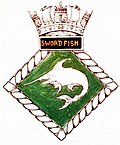HMS Swordfish (61S)

HMS Swordfish
|
|
| History | |
|---|---|
|
|
|
| Name: | HMS Swordfish |
| Builder: | Chatham Dockyard |
| Laid down: | 1 December 1930 |
| Launched: | 10 November 1931 |
| Commissioned: | 28 November 1932 |
| Fate: | Sunk by mine 7 November 1940 |
| Badge: |  |
| General characteristics | |
| Class and type: | S-class submarine |
| Displacement: |
|
| Length: | 202 ft 6 in (61.72 m) |
| Beam: | 24 ft (7.3 m) |
| Draught: | 10 ft 6 in (3.20 m) |
| Propulsion: | Twin diesel/electric |
| Speed: |
|
| Complement: | 36 officers and men |
| Armament: |
|
HMS Swordfish (61S) was a group one British S-class submarine that was sunk on a combat patrol in the English Channel in November 1940 during the Second World War.
The S-class submarines were designed as successors to the L class and were intended to operate in the North and Baltic Seas. The submarines had a length of 202 feet 6 inches (61.7 m) overall, a beam of 24 feet (7.3 m) and a mean draft of 11 feet 11 inches (3.6 m). They displaced 730 long tons (740 t) on the surface and 927 long tons (942 t) submerged. The S-class submarines had a crew of 38 officers and ratings. They had a diving depth of 300 feet (91.4 m).
For surface running, the boats were powered by two 775-brake-horsepower (578 kW) diesel engines, each driving one propeller shaft. When submerged each propeller was driven by a 650-horsepower (485 kW) electric motor. They could reach 13.75 knots (25.47 km/h; 15.82 mph) on the surface and 10 knots (19 km/h; 12 mph) underwater. On the surface, the first-batch boats had a range of 3,700 nautical miles (6,900 km; 4,300 mi) at 10 knots (19 km/h; 12 mph) and 64 nmi (119 km; 74 mi) at 2 knots (3.7 km/h; 2.3 mph) submerged.
The boats were armed with six 21-inch (533 mm) torpedo tubes in the bow. They carried six reload torpedoes for a grand total of a dozen torpedoes. They were also armed with a 3-inch (76 mm) deck gun.
...
Wikipedia
